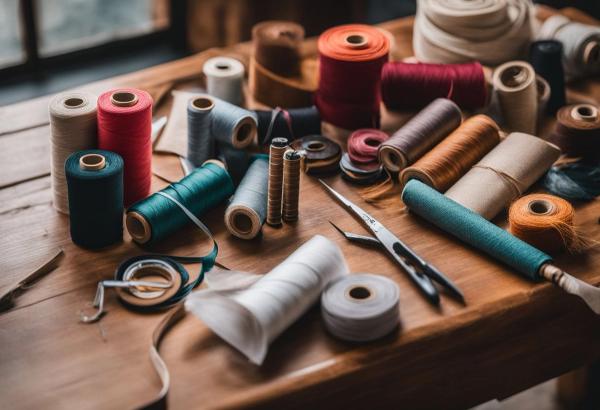13 Ways To Reduce Waste And Carbon Footprint In Sustainable Fashion

By Wildr Editor

The fashion industry is responsible for about 10% of global greenhouse gas emissions. This article will detail 15 actionable ways to reduce waste and lower carbon footprints in the sustainable fashion.
Let's dive into a greener future!
Key Takeaways
- Fashion is responsible for about 10% of global greenhouse gas emissions and can have a significant impact on the environment.
- Taking care of existing clothes, avoiding frequent laundry, choosing the cold cycle for washing, and responsibly disposing of old clothes are effective ways to reduce waste and carbon footprint in the sustainable fashion business.
- Rethinking shopping habits by buying less, supporting second-hand shopping, opting for certified organic fabrics, supporting local fashion brands, and choosing climate-conscious brands can also contribute to reducing waste and carbon footprint.
- Sustainable materials play an important role in reducing the carbon footprint of the fashion industry, while recycling helps minimize waste and environmental impact.
Understanding Fashion's Carbon Impact

Fashion is a sense of expression, a cultural identity; it gives us freedom of style and joy.
But it also hurts our planet…a lot.
In 2018, fashion was to blame for about 2.1 billion metric tons of greenhouse gas emissions. That number has been increasing every year, accelerating our climate crisis and the environmental decline of our planet.
The production of clothes and shoes uses up energy and raw materials. This process alone can cause more than half of fashion's carbon footprint. We call these 'upstream operations'.
Fixing this process by enhancing our manufacturing processes by using renewable energy sources instead of fossil fuels not only help cut costs, but can slash emissions by as much as 60 percent!
First Steps: Caring for Existing Clothes
To reduce waste and carbon footprint in the sustainable fashion, start by taking care of your existing clothes.
1. Wear What You Have
Using clothes that are already in your closet is a powerful way to cut carbon emissions. This act slows the need for new clothing, which often requires energy from fossil fuel sources.
Long wear of garments also helps keep them out of landfills and reduces waste. This step towards sustainable fashion is easy and means you're doing your part to fight climate change.
Taking good care of these clothes makes them last longer too. By fixing small tears or resewing buttons, you give those items more life. Each extra year a piece of clothing gets used cuts its carbon footprint by about 24%.
Sustainable behaviors like this make a big difference over time!
2. Avoid Frequent Laundry
Washing clothes less often can help cut down your carbon footprint. When we wash our clothes a lot, it uses energy and water. It also makes clothes wear out faster, which means you’re shopping more often.
Plus, washing certain types of fabrics can lead to more microplastic pollution in our waters, which can ultimately end up in our own bodies (if you eat shellfish or sushi like we do).
Try to spot clean stains when you can or air dry your garments instead of using the dryer after every wash. This simple change, done collectively by us all, can make a big difference in reducing greenhouse-gas emissions from the fashion industry.
3. Choose Cold Cycle for Washing
Washing clothes in cold water helps the earth because it saves more energy than the other cycles. This simple change can lower the fashion industry's harm to nature by a lot.
That is good news for your power bills too! So next time you do laundry, think cold, not hot.
4. Dispose of Old Clothes Responsibly
Properly disposing of old clothes is an important step in reducing waste and your carbon footprint. Instead of throwing them away, consider donating them to charities or thrift stores.
This way, someone else can make use of them instead of them ending up in landfills. You can also organize clothing swaps with friends or within your community, where everyone brings their unwanted clothes and trades with others.
Another option is to find textile recycling centers that accept old clothes to be repurposed or turned into new products like insulation or cleaning cloths. By responsibly disposing of your old clothes, you can help reduce greenhouse gas emissions and contribute to a more sustainable fashion industry.
Rethinking Shopping Habits

- Buy less, buy better. Support conscious consumerism by purchasing fewer items and investing in high-quality, timeless pieces that will last longer.
- Support second-hand shopping. Embrace the thrifting culture by exploring vintage stores and online platforms for pre-loved fashion finds.
- Opt for certified organic fabrics. Choose clothing made from materials that are grown without harmful pesticides or fertilizers, reducing environmental impact.
- Support local fashion brands. By buying from local designers and artisans, you can reduce transportation emissions associated with global supply chains.
- Choose climate-conscious brands. Look for labels and certifications that prioritize sustainability and have transparent practices to ensure your purchases align with your values.
5. Buy Less, Buy Better
This one’s a biggie. The biggest change is us, as consumers. We can’t emphasize enough how important it is for us to change our shopping habits. One effective way to do this is by buying less and buying better.
Instead of constantly buying new clothes, we should focus on investing in high-quality pieces that are made to last. By doing so, we can decrease the demand for fast fashion, which contributes significantly to greenhouse gas emissions.
Additionally, choosing higher quality items means they will not wear out as quickly and can be worn for a longer period of time, reducing the need for frequent replacements. Buying less also means we are not supporting overproduction in the industry.
6. Support Second Hand Shopping
Supporting second-hand shopping is a crucial step in reducing waste and carbon footprint in sustainable fashion. Secondhand clothing provides an opportunity to address the problem of overconsumption by giving new life to pre-loved items.
Instead of throwing away clothes, which can contribute to landfill waste or incineration emissions, consider passing them on to friends or donating them to charity shops. By extending the lifespan of garments through resale, we can decrease the need for new production and minimize our environmental impact.
Recycling worn or damaged clothes is also a sustainable approach, ensuring that materials are reused instead of discarded.
7. Opt for Certified Organic Fabrics
Choosing certified organic fabrics is a great way to reduce waste and their carbon footprint. Conventional cotton production, for example, involves the heavy use of pesticides and fertilizers that can harm the environment.
Certified organic cotton, on the other hand, is grown without these harmful chemicals, making it a more eco-friendly option. Additionally, organic materials like hemp and linen require less water and energy during production compared to synthetic fibers like polyester.
By opting for certified organic fabrics, you can support sustainable farming practices and send a message to big fashion companies about your values.
8. Support Local Fashion Brands
Local fashion brands have shorter production cycles, which can lead to less waste and a smaller environmental impact overall. So next time you're looking for new clothing or accessories, consider checking out what your local fashion scene has to offer - not only will you be supporting small businesses but also making a positive impact on the environment.
9. Choose Climate-Conscious Brands
Choosing climate-conscious brands is an important step in reducing waste and carbon footprint in the sustainable fashion business. By supporting these brands, you are encouraging responsible practices and helping combat climate change.
Climate-conscious brands prioritize sustainability throughout their entire supply chain, from material sourcing to manufacturing and packaging. They often use renewable energy, reduce water usage, and limit waste generation.
These brands also work towards fair labor practices and support local communities. By choosing climate-conscious brands as a sustainable fashion business owner, you can promote positive change within the industry while meeting the demands of environmentally conscious consumers.
The Role of Sustainable Materials

Sustainable materials play a crucial role in reducing the carbon footprint of the fashion industry.
10. Understanding the Impact of Polyester
Polyester is a type of fabric that is widely used in the fashion industry, but it has a big impact on the environment. In fact, polyester has double the carbon footprint compared to cotton.
This means that producing polyester releases more greenhouse gas emissions into the atmosphere, contributing to climate change. Additionally, the dyeing and finishing stages of textile production, which are necessary for making polyester fabrics colorful and attractive, have the highest greenhouse gas emissions.
So when choosing materials for your sustainable fashion business, it's important to consider alternatives to polyester that have a lower environmental impact.
11. Choose Organic Materials
Organic materials offer several benefits in the fashion industry, particularly in reducing waste and carbon footprint. Choosing organic fabrics like organic cotton helps minimize the use of harmful pesticides and fertilizers used in conventional cotton production.
This practice not only reduces environmental damage but also enhances the soil health. Additionally, organic materials often require less water and energy during manufacturing processes compared to synthetic materials, leading to lower greenhouse gas emissions.
The Importance of Recycling in Fashion
Recycling plays a crucial role in the fashion industry, helping to reduce waste and minimize environmental impact.
12. The Problem with Landfilling Clothes
Landfilling clothes is a big problem in the fashion industry. When we throw away our old clothes, they end up taking space in landfills where they don't break down easily. This leads to waste piling up and contributes to pollution.
Did you know that nearly 75% of all discarded clothing ends up in landfills?
By landfilling clothes, we are wasting resources and adding to the environmental impact of the fashion industry. That's why it's important for sustainable fashion businesses to find alternatives to landfilling and promote recycling and repurposing of clothes as much as possible.
13. The Benefits of Clothing Swaps
Clothing swaps can have significant benefits for sustainable fashion. By participating in clothing swaps, you're buying less which is the ultimate goal.
Swapping clothes helps to decrease the demand for new clothing production, which in turn reduces carbon emissions from manufacturing processes. Additionally, clothing swaps promote the reuse and repurposing of garments, reducing the need for new resources and materials.
By diverting clothing from landfills or incineration, clothing swaps help minimize emissions associated with disposal methods. It’s one sustainable alternative to fast fashion, which is known for its high environmental impacts.
Highlighting Climate-Conscious Brands
Elvis & Kresse, Armedangels, Rapanui, and Mother of Pearl are just a few examples of fashion brands that prioritize sustainability and climate-conscious practices in their operations.
Elvis & Kresse
Elvis & Kresse is a brand that stands out in the sustainable fashion industry. They are known for highlighting climate-conscious brands, which is essential for driving accelerated abatement and creating long-term social and environmental benefits.
Armedangels
Armedangels is a brand that focuses on promoting climate-conscious fashion. They prioritize sustainability in their production and materials, making them an excellent choice for sustainable fashion business owners.
Rapanui
Rapanui is a brand that focuses on products made from natural materials using renewable energy.
By supporting Rapanui, sustainable fashion business owners can promote environmentally friendly practices and support brands that are committed to making a positive impact on the planet.
Mother of Pearl
Mother of Pearl is a luxury sustainable womenswear brand that focuses on eco-friendly and vegan materials in their clothing. This company understands the importance of supporting and promoting ethical and eco-friendly fashion choices.
Fight Climate Change
Every choice matters, even the small ones. You can play your part in reducing waste and carbon footprint in sustainable fashion, which is crucial to mitigating climate change.
By taking simple steps like caring for existing clothes, rethinking shopping habits, seeking sustainable materials, recycling, and supporting climate-conscious brands, you can make a positive impact.



